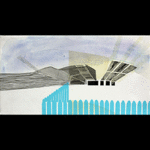Questioning Queerness By Sara Faradji
In a similar way that Caldwell Linker’s All Through the Night exhibition drew us to the Pittsburgh queer communities through a beautifully chaotic documentary photo narrative, the new Yasumasa Morimura Theater of the Self exhibition includes a vast collection of the artist’s visual reprisals of seminal images that also encourage us to reflect on identity, selfhood, and performativity. With this in mind, I am excited to continue the “Questioning Queerness” interview series as a way of connecting the Warhol Museum special exhibitions to the artistic and social interests of the Pittsburgh community.
Stephanie Ross and Scott Andrew are two recent Carnegie Mellon School of Art graduates who I have been looking forward to interviewing for the “Questioning Queerness” blog post series. Their performance, “Pleasure Strike!” was the first act for the Trans-Q Live! event at the Warhol Museum this past September. In this interview excerpt, you can learn more about their performance and their unique experiences working with Trans-Q performers.
During the time that you have lived in Pittsburgh, what have you found to be the most interesting aspects of the queer community?
Scott: I have been living in Pittsburgh since 2006. I initially lived across from the Blue Moon. I used to see maybe three people there when I went. Now, seven years later, the Blue Moon is the center for drag! I now see local people exploring drag and queerness in a more public way, and I also see a lot of talented performers ending up in Pittsburgh rather than in larger cities like Chicago.
Stephanie: What is interesting is that a lot of people within the Pittsburgh queer communities like to work together. Through these networks and connections, people under the radar get gallery shows. And a lot of locals mingle with the drag performers. We make up all different parts of the spectrum.
What do you think is the most unusual or surprising aspect of creating art that explores queerness?
Scott: I think a lot of people would find it surprising that many artists who identify as heterosexual often create work that seems queer or subversive. Also, for a long time I thought my audience would be gay men, but it turns out that’s not always the case! There are a lot of fraternity brothers, some people who are more femme, and some in between who turn out for my shows. I like that this diversity exists.
Stephanie: In a lot of ways, I find pleasure in the fact that my work is almost indigestible; it’s uncomfortable and unsettling. This is a different way to approach an audience.
How would you compare Trans-Q TV to Andy Warhol’s TV?
Stephanie: Andy Warhol’s TV was broadcast locally, rather than nationally. There was a strong emphasis on the local – Andy would take people out of the underground. He wouldn’t just interview big designers, but also Keith Haring, Jean-Michel Basquiat, Philip Glass, and other people who were not well known at the time, but later ended up breaking a lot of ground. And he presented the footage in a way that wasn’t like the usual TV bumpers; they were very creative and nonsensical. Like Andy Warhol’s TV, Trans-Q TV seeks to bring local Pittsburgh artists together with nationally acclaimed ones.
Scott: Also, in a similar way that Andy was the documenter, performer, and director of his program, the members of Trans-Q will assume all of these different roles in creating their segments for the show.
What can we look forward to seeing in future Trans-Q episodes?
Scott: Our new website has launched – it’s transq.tv. We have actually shot enough content in the past year to complete 7-8 episodes. We have filmed segments with Vaginal Davis, John Musser, and – thanks to our partnership with the Warhol Museum – Genesis Breyer P-Orridge!
Can you tell us more about the motivation behind your last Trans-Q performance at the Warhol Museum?
Scott: For our performance, we tried to merge two voices by bringing independent interests to form a marriage. A lot of my work involves entrapment – like the idea of being caught in a portal or being bound in some way. I’m also interested in a playful exploration of transhumanism. What is great about working with Stephanie is that we have a very strong aesthetic overlap.
Stephanie: Yes, my work is also related to transhumanism. It’s not animalistic, but rather a look at how the human and animal merge – how they connect to intimacy, pain, pleasure, and violence. There is often a lot of grappling and dancing in my performance, as I like to play with how non-human characters act in intimate ways.
Scott: Our performance relates to the idea of Trans-Q in that we are relating transsexuality to transhumanism. Along the same lines of what Genesis Breyer P-Orridge might say, I wish we didn’t have bodies. What if we were totally removed from our corporeal entrapment? For this moment – in our performance – we are another being.
Stephanie: In the performance, I’m pulling out a part of myself that didn’t have a body – this part transmutes itself through me – and then it ends when the performance is done.
You can check out Scott Andrew’s work at www.scottnandrew.com and Stephanie Ross’ work at www.stephanielhross.com.


